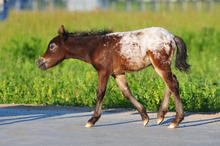Research studies show the importance of checking new foals for deviations in limb conformation as they grow and develop. Diagnosing irregularities in development is important in providing early intervention before limbs sustain damage that may cause lameness and limit the horse's athletic abilities.

Assessing limb conformation in foals
Diagnosing irregularities in development of a foal's limbs is key in providing early intervention before limbs sustain damage that may cause lameness and limit the horse's athletic abilities.
Newly born foals exhibit three types of forelimb conformational deviations in the frontal plane: angulation, rotation and carpal offset. The evaluation of limb conformation in foals destined for athletic competition should be done as soon as possible after birth so necessary interventions can be performed before permanent damage occurs.
In one study of Thoroughbred foal conformation, only 13% of foals were considered to have straight limbs when evaluated during the first 10 days of life; however, only a very small number of foals warrant specific therapy.
Angular deviations occur due to metaphyseal, epiphyseal or intra-articular abnormalities and are usually related to the closest joint, usually the carpus, hock or fetlock. More than one joint can be affected, and although rare in new foals, abnormalities can occur in different joints in one limb.
Rotational deformities are also quite common in newly born foals. Rotational deformities appear to originate most commonly in the forelimb. Rotational deformities in the hind limb can appear to originate more proximally, including proximal to the stifle. In neonates, in both the forelimb and hind limb, the direction of rotation is almost exclusively outward.
Foals born after a full gestation length have varying degrees of ossification of their skeletal system at birth. The impact of the degree of ossification, particularly of the cubodial bones, on conformation is only understood at the extremes.
The most common deviation in the neonate requiring treatment is severe carpal valgus either due to epiphyseal/metaphyseal dysplasia or carpal ligamentous laxity. If a deviation id due to laxity, manipulation will straighten the limb. Abnormal bone morphology will be revealed by radiographs. Therapy is initiated early in these cases to protect the growing limb; especially the lateral structures from crush injuries.
The causes of conformational deviations are a matter of some debate, and genetics and external forces are the major factors considered.
Genetic influences include the individuals' assortment of alleles that control bone formation and growth, and those that modulate bone remodeling. External forces include the intrauterine environment, postnatal limb loading, nutrition of the foal and dam, and trauma are impacted by both genetics and external influences. Presently, this complex situation is incompletely understood, but is seems clear that both biological and mechanicobiological influences must be considered when evaluating the growth of long bones.
Less common conformation deformities in young foals include windswept conformation, diaphyseal deviations, gross congenital malformations, and acquired varus deformities of the carpus and fetlock. Windswept foals have limbs (usually both front or both hind) that are curved in the same direction in the frontal plane.
Horse owners with new foals should pay close attention to the growth and development of their foal's limbs, especially in foals that are destined for athletic competitions, so that proper intervention can be taken before damage that will affect their athletic ability occurs in the limbs.
